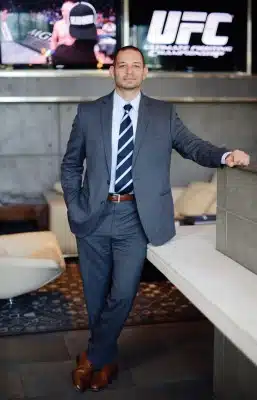Have you encountered any misconceptions about the Ultimate Fighting Championship (UFC) in new markets?
I’ve been in countless meetings with high-level media executives, and within the first few minutes I realize that there are some basic and fundamental misconceptions about the brand. But by the end of the meeting, after having a chance to showcase the UFC as a sport, the executives are ready to strike a deal. When we tell people there have been no deaths or serious injuries in the UFC, they are usually surprised. There are men and women in every country who love this sport, and they understand that the fighters are amazing athletes. It’s a contact sport, of course, but it’s actually one of the safest contact sports. As a new audience starts to learn the sport, the virtues of martial arts get reexposed. UFC is about respect, discipline, hard work, athleticism, and hours of daily training. That is why lot of the fighters become role models.

How have you seen the UFC’s presence and popularity in Latin America change?
When I started, there was very little awareness of the UFC in Latin America. There were pockets of fans in Mexico and parts of Brazil, and it was a very fringe, niche fan base. Over the last three to five years, we’ve been able to build the UFC brand in the majority of the Latin American countries, including Argentina, Colombia, Ecuador, and Peru to name a few. Today, there is a much broader awareness level of the UFC brand as a worldwide sport, and its relevance is known within the different cultures.
What major deals have changed the UFC’s scope in Latin America?
There have been three big media deals for the company. The first was our partnership with Fox Sports. The second, our strong partnership with TV Globo in Brazil, and now we are proud to have a working relationship with Televisa. We recently did an announcement about our partnership with Televisa to produce a localized version of the Ultimate Fighter reality show. We conducted a media tour and press conference in Mexico City this past May. More than 350 people attended, including media outlets from the entire region. It was one of the largest press conferences, both for the UFC and for Televisa.
What makes the Latin American market unique?
I think Latinos in general have a fighting spirit. I see a passion in Latin Americans that is different from anywhere else in the world. We see it in our fan base. We see it in our fighters. For the UFC, there are top athletes coming from Latin America, and they’re proud to exhibit their spirit. The UFC fighters have an incredible platform to become role models in their countries.
Another unique aspect of Latin America is that the popularity of soccer is ubiquitous, like nowhere else in the world. Outside of soccer, other sports are more niche. With sports in the United States (baseball, football, hockey, and basketball), there is much more variety and much more competition for popularity between sports. In the Latin American region, many sports fans have been looking for outlets other than soccer, and until recently, other relevant content didn’t really exist. There is an
opportunity for the UFC to fill that demand.

How have marketing initiatives shifted to appeal to Latin American cultures?
The tactics are very straightforward. I think the product itself is impressive, and the basics of it cut through all languages, races, skin colors, and economic backgrounds. We also try to highlight how the Ultimate Fighter is a great platform for education and awareness. It serves as a great tool to show people how the fighters train together, what their background stories are, and where they come from. For example, many of the fighters are fathers and husbands who support their families. There are fighters with college degrees. They’re regular people, and this is their career.
What is your next step in growing the UFC’s presence in Latin America?
It all starts with cultivating great relationships, and at this point we have built strong relationships in almost every country. We’re so interconnected with our fans—more than any other sport that I know of. So when the media platform is broad enough to reach the fan on a daily basis, it allows growth for casual and avid fans to make connecting with the sport a part of their lifestyle.

